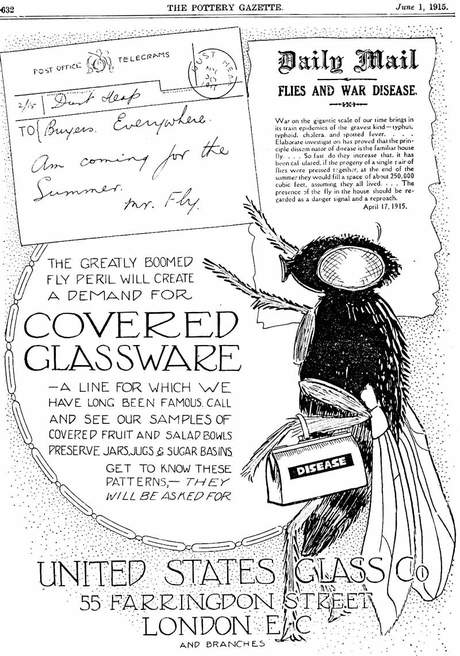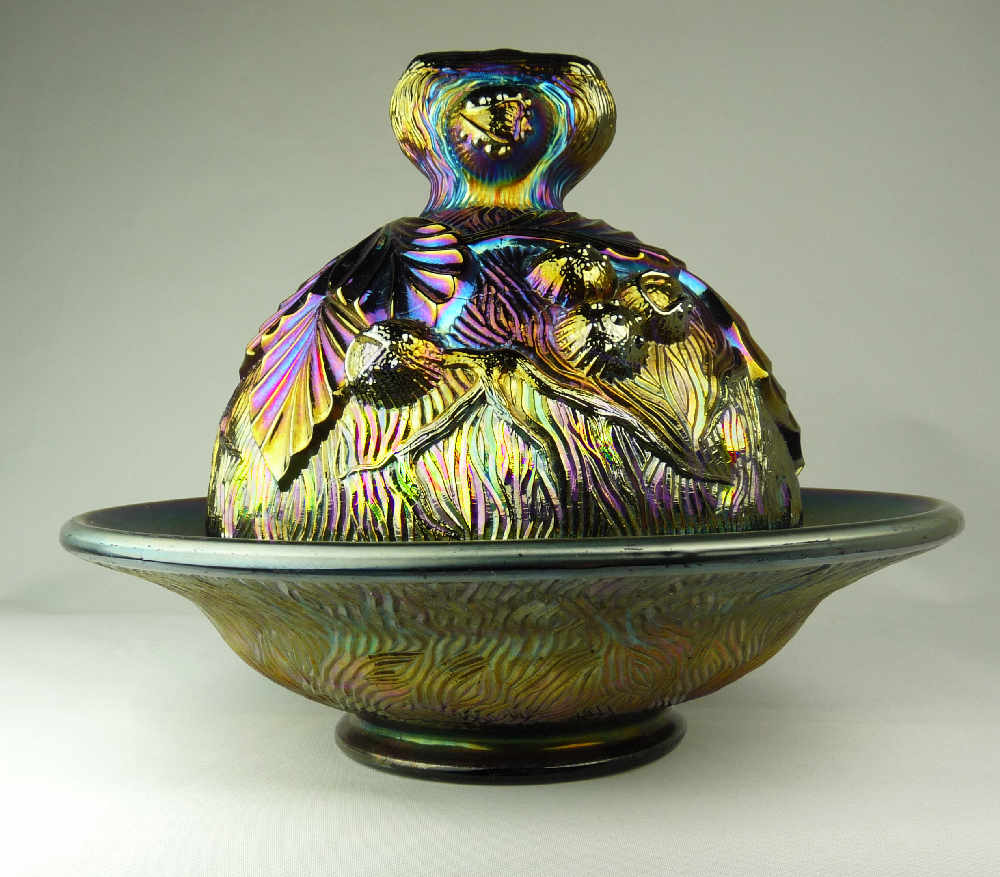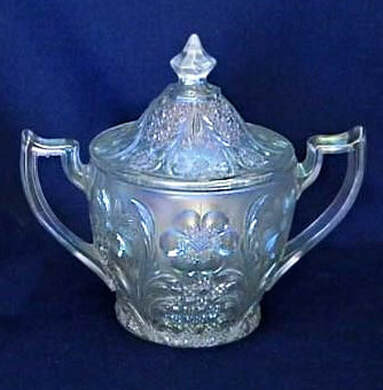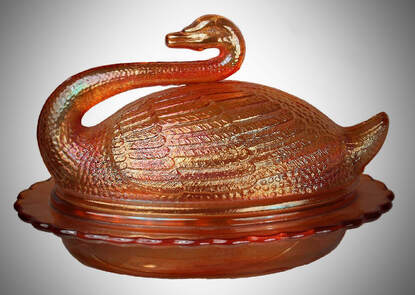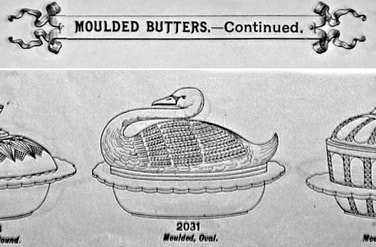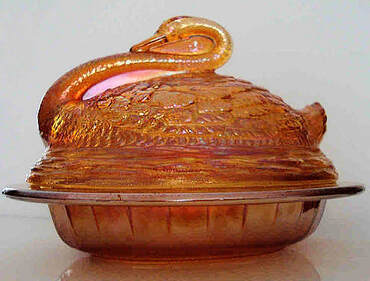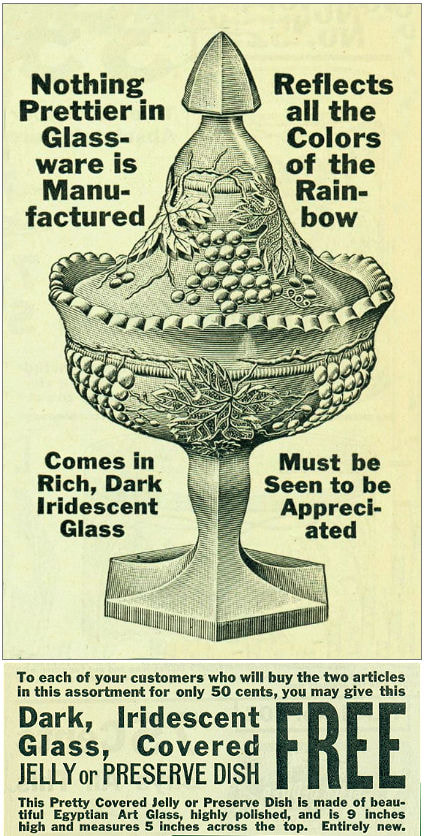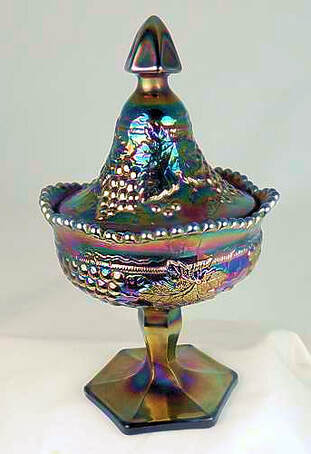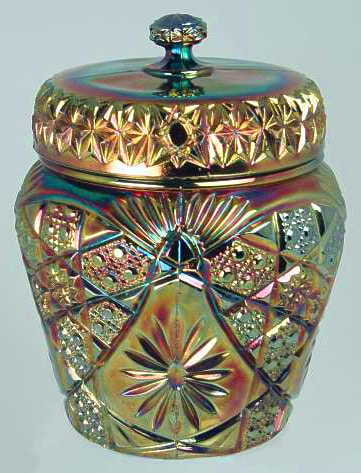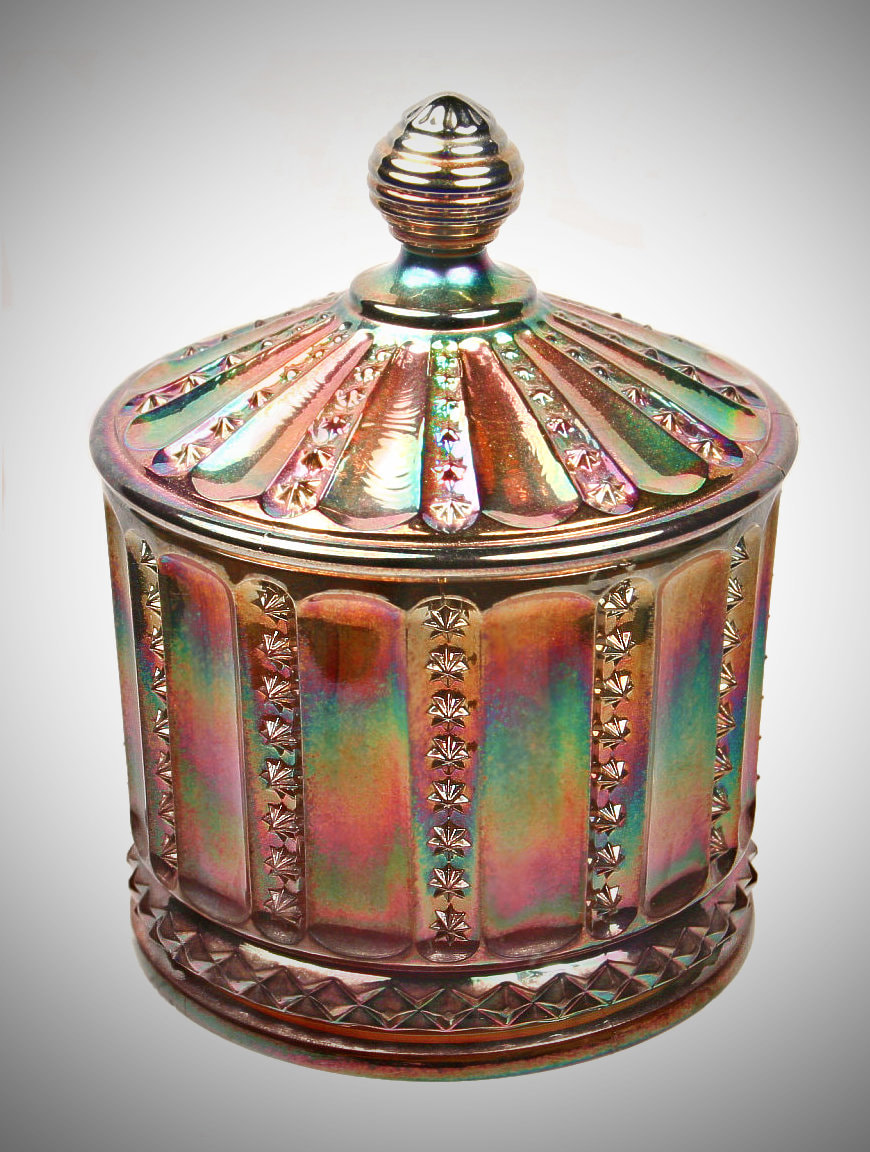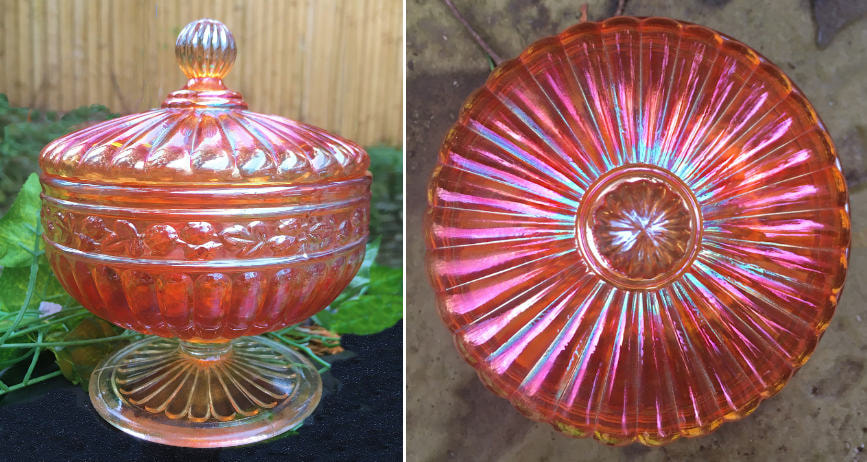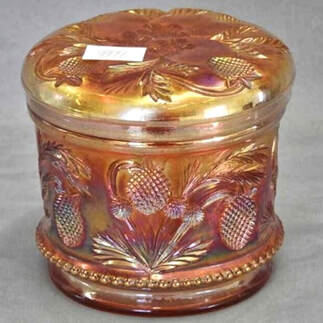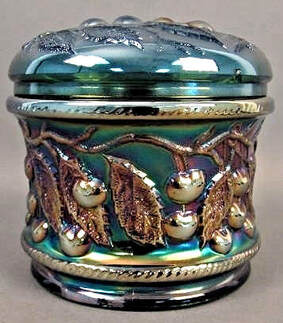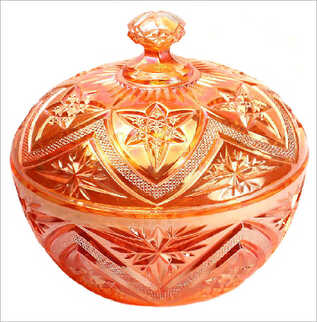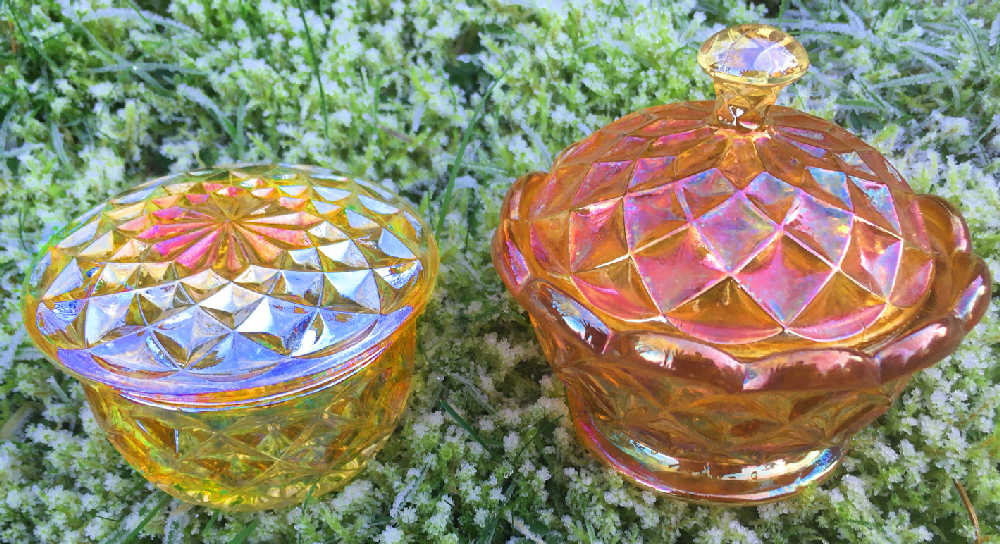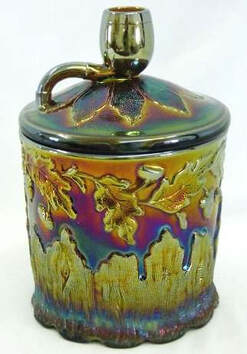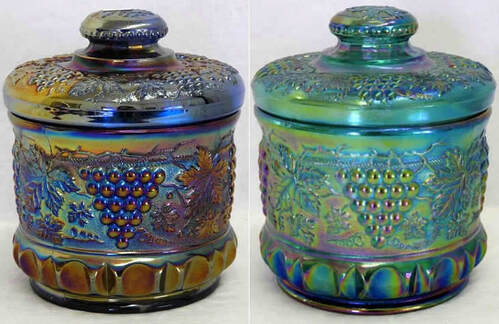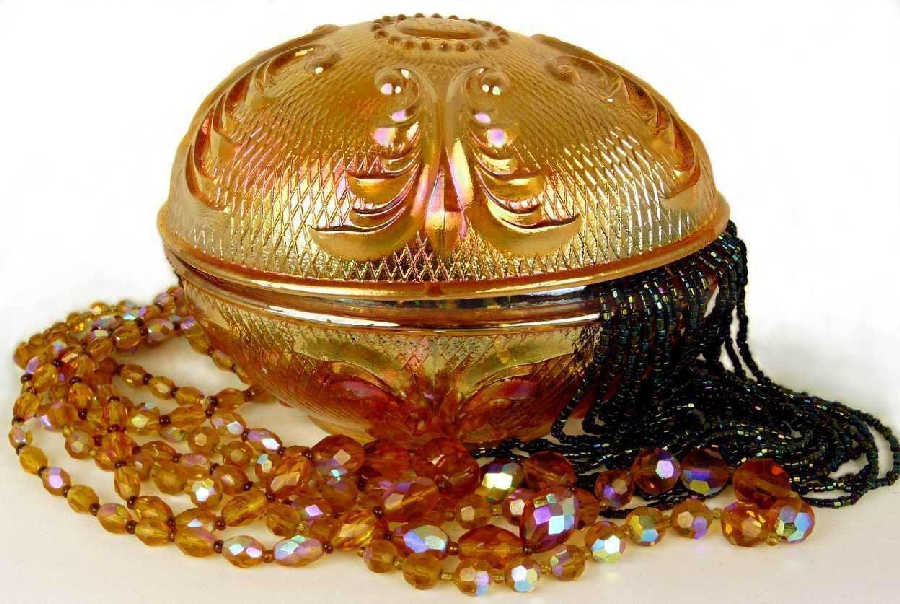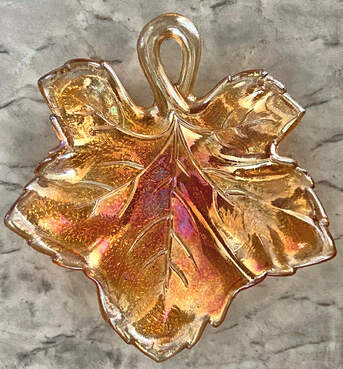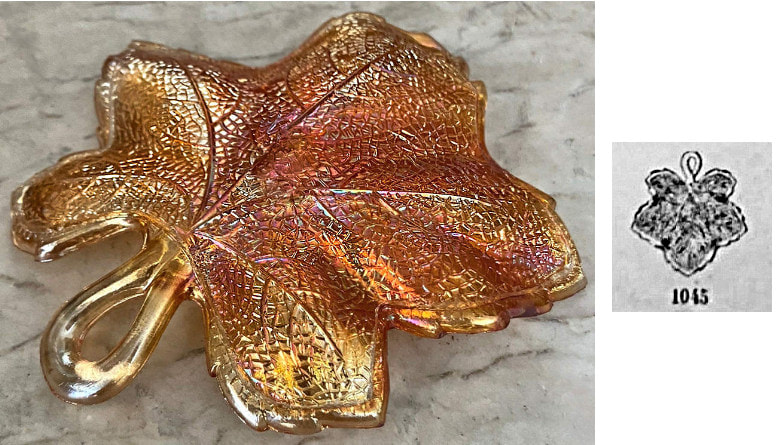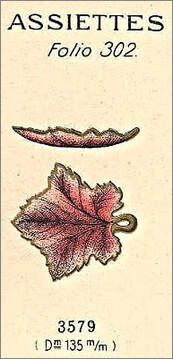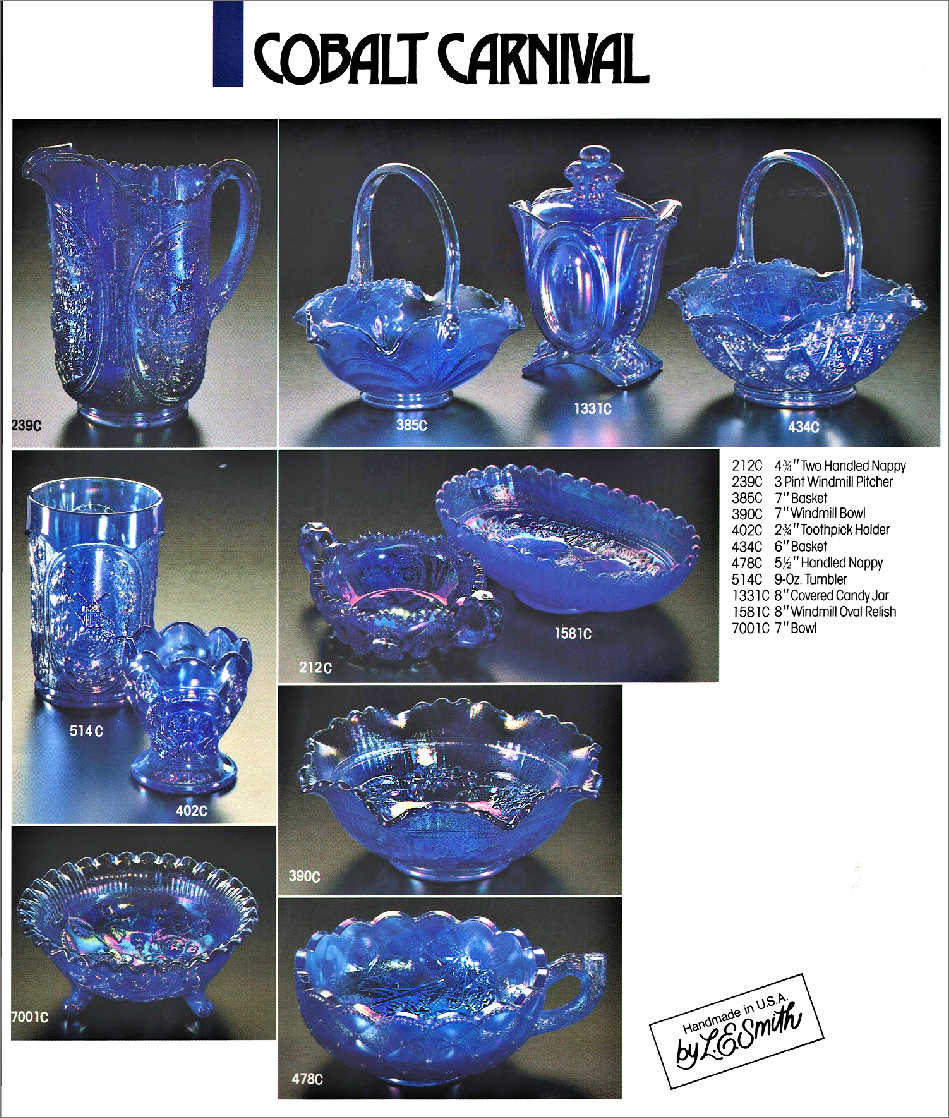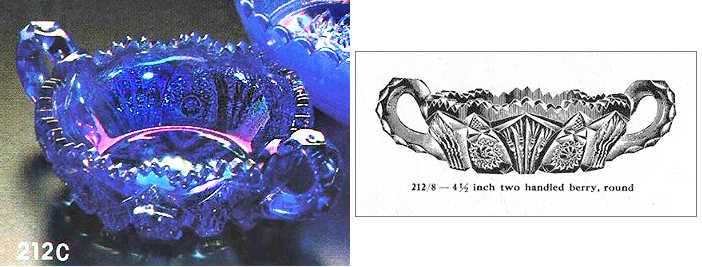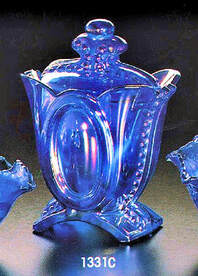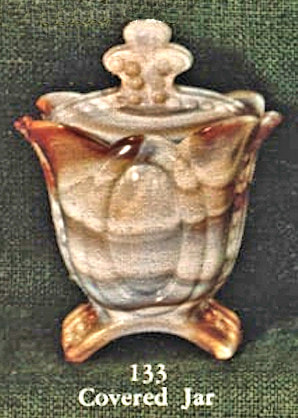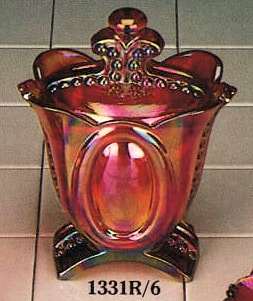NetworK ezine Issue 93. February 2023
Totally Devoted to Carnival Glass
|
Put a Lid on it! Carnival Glass items with lids – often referred to generally as "covered" pieces – are always a delight. There’s something rather delicious about that extra piece, and of course, it’s always a bonus to know that you have the matching lid and it hasn’t vanished or been broken, over the years. Lids or covers are obviously useful on some items intended for food storage, but there are other uses for lids too, on some shapes you might not have known about. So, let’s take a worldwide tour and see what a wide range of charming, covered items exist. Covers for Food Naturally, we like to cover food for hygienic reasons, and in 1915 (with World War One in Europe in its early days), the United States Glass Company promoted their covered glassware sales in Britain with this somewhat disturbing ad (albeit surely very effective). Above: United States Glass Co. ad in the 1915 British Pottery Gazette
|
Northwood’s Acorn Burrs butter, Photo Stephen Thistlewood.
The ad on the left was headlined with a snippet from a UK Daily Mail newspaper article titled “Flies and War Disease” which warned that typhus, typhoid, cholera and spotted fever were all spread by the house fly. The reader was urged to purchase the U. S. Glass products with the warning that “the greatly boomed fly peril will create a demand for covered glassware”. Above: a lovely U. S. Glass piece - a Cosmos and Cane
covered sugar in white. Courtesy Seeck Auctions. |
|
Covered butter dishes were made in a variety of shapes. Northwood’s Acorn Burrs butter is especially attractive with its unusual finial (see photo at top of this of ezine). In England, Sowerby made a Covered Swan butter is both distinctive and easily recognisable. The early version of the Sowerby Covered Swan butter was made in marigold (below) and also in rare amethyst. Sowerby's made the Covered Swan butter in Carnival in the early 1920s using an old mould that was originally used in the 1880s. Sowerby’s Covered Swan butter dish in marigold.
Photo Stephen Thistlewood. It is interesting that Sowerby made another, slightly later version of the Covered Swan butter. On this subsequent version the neck is filled in with glass, but also note that both base and top are very different from the 1880’s version. The later version of the Sowerby Covered Swan was made mainly in blue – but we can also confirm marigold, as you can see here on the right. In fact, this is the only marigold example of the later Swan that we are aware of. |
Extract from Sowerby’s 1892 Pattern Book showing the Swan butter.
Sowerby’s Covered Swan butter dish in the slightly later version.
This is the seldom seen marigold example. Photo Stephen Thistlewood. |
|
As well as lidded items for table sets, there were many other covered items for food, such as cracker jars or cookie (biscuit) jars and covered pieces for candies and sweets. Probably one of the best-known patterns in lidded items for food is Northwood’s Grape and Cable – in the form of the cracker jar, covered compote and the elegant sweetmeat. It is a delight to see the item that collectors know as Northwood’s Grape and Cable sweetmeat in a 1912 Lee Manufacturing catalogue, on the right. Note that it was described as a “jelly or preserve dish” and the evocative term “Egyptian Art Glass” was used to acknowledge its splendid iridescent appearance. Amazingly this this beauty was offered free! All the customer had to do was purchase tooth soap and talcum and they would receive a glorious covered piece of Carnival. |
Cookie jars, pickle jars and other lidded items are known aplenty from glass makers in Europe.
Shown below are three wonderful examples. There is the amazing Triple Alliance biscuit / cookie jar from Brockwitz which is a rare beauty – the lid is always the really hard part to find. Also shown are two covered pots for candy, called bonbonnieres or bonboniers, from the Nordic makers Eda and Karhula.
Shown below are three wonderful examples. There is the amazing Triple Alliance biscuit / cookie jar from Brockwitz which is a rare beauty – the lid is always the really hard part to find. Also shown are two covered pots for candy, called bonbonnieres or bonboniers, from the Nordic makers Eda and Karhula.
|
The South American glass makers also produced some stunning covered items, including lidded comports. You can see a Berry Band and Rib example on the right, made by Cristalerias Piccardo of Argentina. We have links to view more at the end of this feature. Shown on the right: a super cute Berry Band and Rib
stemmed, covered comport in marigold, made by Cristalerias Piccardo of Argentina. The photo on the far right shows the ribs on the lid. Photos by Glen Thistlewood. Our sincere thanks to Joan Doty. |
Covers for Dressing Table Sets
Dressing table sets (also known as boudoir, vanity, toilet or trinket sets) provided the perfect opportunity for a variety of lidded items to be made – for powder, pomade and more. Here is a small selection.
Dressing table sets (also known as boudoir, vanity, toilet or trinket sets) provided the perfect opportunity for a variety of lidded items to be made – for powder, pomade and more. Here is a small selection.
Boudoir sets and individual covered jars were popular in European Carnival. Probably the largest covered powder reported in Carnival Glass is the Brockwitz Curved Star example. Whilst at the other end of the size scale are some delightful items from Eda Glasbruk in Sweden.
|
Curved Star powder box ("puderdose") in marigold by Brockwitz. Photo Stephen Thistlewood. It is a massive piece of glass. Measuring almost 8 inches across (20 cm) and 7 inches high (18 cm), it holds a very large amount of powder! It requires two hands to hold it, as it's so big, and it weighs just under 3 pounds. Photo Stephen Thistlewood.
|
Svea button box (left) and a powder jar with finial, in marigold, made by Eda. Photo Glen Thistlewood. Our sincere thanks to Joan Doty.
For those interested in the comparative sizes, here are the approx. measurements: Button Box - tiny! Just under 2.25 inches (5.5 cm) across its base, just under 3.5 inches (8.5 cm) across the top and 2 inches (5 cm) high. Powder Jar - 2.5 inches (6.25 cm) across its base, 4 inches (10 cm) across the top and 4 inches (10 cm) high to the top of the finial. |
|
Covers for Tobacciana Let’s not forget the humidor, a very special covered piece for sure. Shown below (left) is a Millersburg Pipe Humidor with the very unusual pipe-shaped handle on the lid. Courtesy Seeck Auctions. |
Shown above are two Grape and Cable humidors. The one on the left is a Classic old one in blue made by Northwood, and the one on the right is a Revival Carnival version in aqua made by Fenton. Both photos courtesy of Seeck Auctions.
Fenton's version was introduced in the late 1960s as an "authentic reproduction", and was called a “Tobacco Jar”. A significant feature that distinguishes the two is that the old Northwood version has three prongs inside the lid (to hold a dampened sponge to keep the tobacco moist and fresh); there are no prongs on the new Fenton version. |
|
Covers for "Treasure" Strictly speaking this oval egg-shaped covered piece is a bonbonniere, but we like to think of it as being used to hold some form of surprise treasure (edible or otherwise)! So far, it is the only one we know of reported in Carnival. It is almost 5" long (12.5 cm) and 3.5" high (9 cm), and it was made by Zabkowice of Poland. We gave it the pattern name Renaissance, in recognition that that the Zabkowice design could have been inspired by Fabergé’s famous Renaissance Egg. We have a full article about this little treasure in our "Collectors Facts" Series: Zabkowice's Renaissance Egg Here is some further reading about covered pieces on our website: Humidors: NetworK #41 Carnival Glass from Argentina: Cristalerias Piccardo Amazing covered comports and more from Claudio Deveikis: Esberard Gallery |
Esberard’s Grape Leaf
Wonderful news from glass researcher Claudio Deveikis in Brazil – a previously un-reported Carnival item has been found and so another fascinating piece can be added to the growing list of beautiful Carnival from the Esberard glass works in Brazil. The pattern has been named "Folha de Uva" which translates as Grape Leaves.
Wonderful news from glass researcher Claudio Deveikis in Brazil – a previously un-reported Carnival item has been found and so another fascinating piece can be added to the growing list of beautiful Carnival from the Esberard glass works in Brazil. The pattern has been named "Folha de Uva" which translates as Grape Leaves.
|
Grape Leaf made by Esberard. Photo courtesy "Versieux Arts".
This charming little item measures 5.5 inches (14 cm) by 5 inches (13 cm) and its purpose is to hold the discarded parts of fruits eaten at the dining table. A sort-of side plate, where the diner would deposit pips etc., probably from grapes, as suggested by the shape of this pretty little grape leaf shaped dish. It has a delightful marigold iridescence and note the intricate pattern on the exterior – an attention to detail that elevates it to the next level of beauty. The plate was in Esberard’s catalogue, c. 1940s. We found what could have been the inspiration for this pretty piece in the French Vallerysthal and Portieux catalogue dated 1908, shown here on the right. It was described as a plate ("assiette"). Note, it was not made in Carnival by the French company. Claudio tells us that the owner of the Esberard glass works, Antonio F. Esberard, was himself, French. Did he have connections with Vallerysthal and Portieux? Maybe the mould was purchased or the design was simply copied – we don’t know the answer for certain. (A larger leaf shaped dish was also shown in the Vallerysthal and Portieux catalogue, which we think probably inspired a similar item made by the Indiana Glass company). |
Grape Leaf made by Esberard. Photo courtesy "Versieux Arts".
Extract from Esberard catalogue, c. 1940s. |
L. E. Smith or Imperial … a Mystery
In the mid-1980s, Smith purchased numerous Imperial moulds after their closure. In Smith’s 1986-7 catalogue (below) we see a wide array of former Imperial pieces being produced in Carnival (mainly red and cobalt blue, but also some white). Many of them are familiar patterns, and we are sure you will be able to spot them in the Smith catalogue image below. You can see it full sized here: L E Smith Cobalt Blue
The Smith catalogue and extracts, 1986-7 are courtesy Glass Paper Fanatics.
In the mid-1980s, Smith purchased numerous Imperial moulds after their closure. In Smith’s 1986-7 catalogue (below) we see a wide array of former Imperial pieces being produced in Carnival (mainly red and cobalt blue, but also some white). Many of them are familiar patterns, and we are sure you will be able to spot them in the Smith catalogue image below. You can see it full sized here: L E Smith Cobalt Blue
The Smith catalogue and extracts, 1986-7 are courtesy Glass Paper Fanatics.
|
L. E. Smith catalogue page, 1986-7. Courtesy Glass Paper Fanatics.
Diamond Lace, Windmill, Fashion, Scroll Embossed, Pansy and Imperial Rose – they are all easy to find. Two items are less familiar - #212 and #1331, and one of them leads us into an interesting puzzle. |
Item 212 (aka Diamond with Fans) the Handled Nappy, was made by Imperial in crystal in their early years - the catalogue image, above right shows it in crystal, in 1912. It was produced by Imperial again in Revival Carnival from the 1960s, in the shape of a little comport. Here it is from Smith in a blue Carnival two handled nappy. Note how Smith used the actual Imperial number 212 for it.
The other intriguing item of interest, which was a real puzzle to unravel,
is the covered candy jar 1331C. |
So, item #1331 is shown in blue in this extract from the Smith 1986-87 catalogue, but we also have it in another Smith catalogue from the 1980s - one featuring red Revival Carnival. This provoked two questions:
|
1. What was its pattern name?
2. Who made it in Revival Carnival? We asked ourselves this second question because we had seen it referred to online as being known in red Carnival with an IG (Imperial Glass) mark. We’ll cut a long story short! The #1331 pattern name We discovered that it had been made by Imperial in the 1960s in non iridised caramel slag, in two shapes - a comport and covered jar (shown, right). Imperial simply called it "133 Covered Jar", but it was given two different pattern names by collectors and it is usually referred to as Saddle or Zipper. Note how Smith again used a catalogue number (1331) that was close to Imperial's original #133. Who made it in red in Revival Carnival? It has been found in red Carnival with an IG mark - but did Imperial actually make it? Evidence suggests that they did not! Number 133 is neither shown in the Imperial catalogue page of Sunset Ruby, and nor is it in the Presznick listing of Imperial’s IG Sunset Ruby items. The only definite Imperial attribution of this item is in non iridised caramel slag, as above. There might be others, but we have not yet come across them. We do however know it was definitely made in red Carnival by L. E. Smith, as here is an extract showing it in a Smith catalogue from the 1980s. We think we have the answer to the mystery: IG marks were not always removed from some of the Revival Carnival made by Smith using acquired Imperial moulds.
We believe that the red Carnival items were made by Smith; in the 1980s, when Smith began using the moulds acquired from Imperial for Revival Carnival, they did not initially remove the IG (or other) markings. Thus, there are a number of items in circulation, marked IG that were actually made by Smith. And we have proof – in the form of a letter from Hank Oppermann, president of Smith Glass, written in January 1986. We showed this in our NetworK ezine #74 (July 2021) where you can see a copy of the actual letter (link below). Here is the crucial part of what Oppermann said. Smith produced items made from “Imperial moulds with Imperial logos intact” in the mid-1980s – and the amberina (red) Carnival items were included, which appears to be why a red Carnival Saddle covered jar is known with an IG logo on it. It was made by Smith before they removed those Imperial trademarks and replaced them with their own S or SGC marks Mystery solved – we think. Here is the link to Oppermann's letter: NetworK #74 |
Privacy and the use of your information: we only use your name and email address to send you your Carnival Glass NetworK ezine. We will not share your name or email address with anyone else, or use it for any other purpose. You can change your mind about receiving your NetworK ezine at any time by clicking the unsubscribe link at the foot of every issue, or by emailing us at [email protected]
Join us on Facebook
We invite you and your friends to join us all on NetworK's fast growing and very active Facebook Group (link is below), and if you have missed any of the previous issues of NetworK and NetworK Specials, they are all here: Back Issues.
We invite you and your friends to join us all on NetworK's fast growing and very active Facebook Group (link is below), and if you have missed any of the previous issues of NetworK and NetworK Specials, they are all here: Back Issues.

